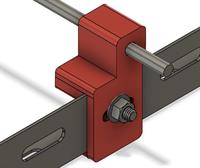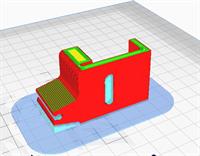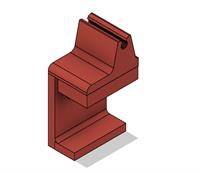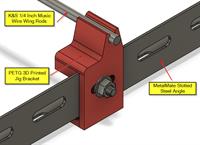Wing Jig Part 1 - June 2020
After building two twisted wings, one which led to the loss of the aircraft, I decided it was time to start using a wing jig.
I happened to be at a local Bunnings Hardware store one day and came across a product called MetalMate. This is a slotted steel angle product that can be used to build shelving and small sheds.
MetalMate also provides hardware packs containing brackets, bolts, and nuts.
The dimensions of the slotted angle are 32mm X 32mm X 1.5mm. It comes in the following lengths 600mm, 900mm, 1200mm, 1800mm and 2400mm.
When assembled the angle which the jig brackets would be attached to, was not a perfect 90 degrees to the jig base so I bent these using a Stilson wrench so that they as close to 90 degrees as possible. I used a spirit level to check.
I purchased enough material to create a wing jig that was around 1 X 0.5 metres so that a K & S 1/4 inch Piano Wire would be able to be used as wing rods.
To keep the wing ribs perpendicular to the wing rods I used ceramic disk magnets which are 19mm in diameter and 3mm thick. They come in a pack of 6 and are fairly inexpensive. Once the spars, leading edges, and trailing edges are glued in place the wing rods are removed and the magnets slid off. The wing rods are then re-inserted into the wing for further work. When using Cyanoacrylate glues you should be careful not to get any near the magnets otherwise these will be stuck to the ribs and could lead to the ribs being damaged when you try to remove them.
I designed some wing jig brackets in Fusion 360 and printed these on my Creality Ender 3 Pro 3D Printer using Polylite PETG filament. These slip over the slotted angle and can be fixed in place using the nut and bolts provided with the MetalMate hardware pack.
The reason for using Polylite PETG was that this material is more flexible than PLA and can withstand higher temperatures. The initial design had the wing rods passing through a hole in the bracket.
The final design allows the wing rods to snap into the brackets, making it easy to quickly remove the wing and flip it over to work on the other side. The brackets need to be printed in the right orientation to allow for the rod slot to easily spread when snapping the rod in place.
I printed extra brackets so that these could be put on the inner cross braces and placed between the ribs to provide extra support for the jig rods.
I have designed brackets that can hold 5/32 inch wing rods and these will be used when I build a wing with washout. These will be used in the rear wing jig holes. This will be covered in the next blog article.
So far I have built 2 wings one for a DAS Mini Stik and another for my Gee Bee R2 Block 2 design. The Gee Bee has a semi-symmetrical MH 43 airfoil. Both wings have turned out perfectly straight with no twists.
No Comments
Date Posted: 29/06/2020 10:00:00 PM

Winfoil 3 Other Details
User Portal
Articles
- 2FA
- 3.0.49
- 3.0.51
- 3.0.52
- 3.0.53
- 3D Printing
- 3D Printing for RC Aircraft
- About
- Activation Enhancement
- Airfoil List Screen Enhancement
- Airfoil List Screen Enhancements 2
- Airfoil Plotter
- Airfoil Plotting
- Airfoils
- Airfoils not showing after import
- April 2020
- APRIL 2021
- August 2020
- CNC
- CNC Router
- Creality
- Decals
- Default Length Units
- Design Specification
- Download Winfoil
- DXF Export Enhancement
- End Mills
- Ender 3 Pro
- FEBRUARY 2021
- Issue
- JANUARY 2024
- Jig Hole Washout
- July 2020
- June 2020
- Lost Password Link Issue
- March 2020
- MARCH 2024
- MAY 2020
- October 2020
- Print Orientation Issue
- Roadmap
- Show Password
- Two-factor Authentication
- V3.0.45
- V3.0.52
- V3.0.53 APRIL 2021
- V3.0.55
- V3.0.56
- V3.0.57
- Version History
- Washout
- Weight and Balance
- Winfoil V3.0.51
- Winfoil V3.0.52 MARCH 2021
- Wing Plan View
.jpg)
.jpg)
.jpg)
.jpg)
.jpg)
.jpg)
.jpg)
.jpg)
.jpg)
.jpg)
.jpg)
.jpg)
.jpg)
.jpg)




